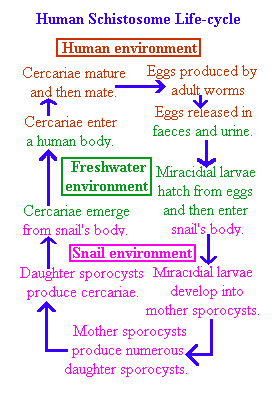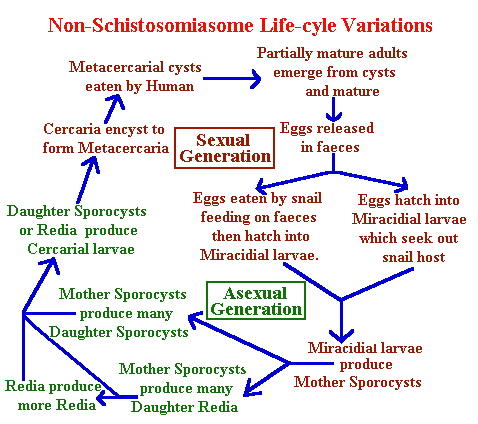Flukes = The Digenea
Digeneans have what is called an 'alternation of generations' in their life cycle. This means the egg hatches into a larval form, this larval form reproduces asexually to produce numerous copies of itself. eventually these copies change into another larval form which in time grows into a sexually reproducing adult. This possession of an asexual generation means that a single egg can produce not just one infectios agent, but many, maybe even tens or hundreds of thousands.
Only about 12 of the 6,000 known species are infectious to mankind, but some of these species are important diseases with of 200 million people infected world wide. The species that infect humans can be divided into groups, the Schistosomiasomes and the non-Schistosomiasomes.
![]()
The Schistosomiasomes
The Schistosomiasomes are all parasites of the circulatory system of their primary host, meaning they live and feed inside the blood vessels. Because of this they are all very thin animals, ranging in size from 10 to 30 mm (0.43 to 1.26 ins) in length to 0.2 to 1.0 mm in diametre. The males are shorter and thicker than the females. Females only reach sexual maturity after they have been mated by a male, the male has a long groove along one entire side of his body that he uses to clasp the female. After mating the two remain locked together for the rest of their lives. they can live for several years and produce many thousands of eggs.
The eggs are simply released into th blood vessels where they are carried away from the major vessels to the capillaries. The eggs tend to collect in the capillaries and this can be a problem in heavy infestations. The eggs are oval, but have a sharp spine on one end. This spine allows some of the eggs to rupture the capillary wall and escape into the host tissue. Eventually some eggs will escape from the animal via the urine, faeces or spit and if they are lucky enough to find their way into a water body they will hatch.
 The eggs hatch into a sort of larvae called a Miracidium (pl. Miracidia). These Miracidial larvae seek out an aquatic snail and enter its body, here they turn into another sort of larvae called a Sporocyst. The Sporocyst is the asexual generation and it produces many daughter Sporocysts. Sporocysts eventually become a third larval form called a Cercaria (pl. Cercariae). These Cercariae leave the snail and actively seek out the mammalian host.
The eggs hatch into a sort of larvae called a Miracidium (pl. Miracidia). These Miracidial larvae seek out an aquatic snail and enter its body, here they turn into another sort of larvae called a Sporocyst. The Sporocyst is the asexual generation and it produces many daughter Sporocysts. Sporocysts eventually become a third larval form called a Cercaria (pl. Cercariae). These Cercariae leave the snail and actively seek out the mammalian host.
The host is penetrated through the skin while it is in the water. Cercarial larvae are not able to recognise the correct mammalian species so they just infect any mammal. Large numbers of cerariae die as a result of penetrating the wrong host. Each species is specifically evolved to survive the immune system of a particular mammal species, in the wrong species they are killed off. In humans this can cause a non-infectious temporary discomfort known as swimmers itch.
Four species of Schistosomiasis are found to effect human beings, they are all members of the genus Schistosoma and all have snails as the intermediate host, S. mansoni is the most common while S. japonicum represents the greatest problems in control because it infects a large number of non-human mammals such as Cattle, Dogs and Rats.
| Species Name | Snail Species | Distribution |
| Schistosoma mansoni | Biomphalaria spp. | Africa, Brazil, the Caribban, Egypt, Malagasy, the Middle East and Venezuela. |
| Schistosoma haematobium | Bulinus spp. | Africa, the Middle East, Malagasy. |
| Schistosoma japonicun | Oncomelania spp. | China, Eastern Asia and the Philippines. |
| Schistosoma intercalatum | Bulinus spp. | Central Africa. |
The Non-Schistosomiasomes
The non-Schistosomiasomes Digeneans are often called 'Flukes' because of their flat leaf shaped bodies. Ecologically the main difference between the The non-Schistosomiasomes and the Schistosomiasomes is that in the non-Schistosomiasomes the cercaria larvae never leave the intermediate host and actively seek out the primary host. Instead they form cysts on vegetation or in the snails body, or in the body of an animal which has eaten the snail. Thus the primary host always becomes infected as a result of eating material contaminated with encysted cercaria or metacercaria.
There seven major species of non-Schistosomiasomes which infect mankind, all of them infect people when they are eaten as metacercarial cysts, all leave humanity in human faeces. One species, Paragonimus westermani lives in the lungs, and so can also have its eggs passed out in spit. The other six species live in the human digestive system. Normally infection with these parasites is mildly to (occasionally) seriously unpleasant, only very rarely is it life-threatening.
 |
| Scientific Name | Snail Genera | Location of Cysts | Distribution |
| Fasciolopsis buski | Segmentina | Plants-Caltrop and Water Chestnut | Asia and India |
| Heterophyes heterophyes | Pirinella, Cerithidia | Fish- Mullet, Tilapia | Asia, E. Europe, Egypt, Middle East |
| Metagonimus yokogawaii | Semisulcospira | Fish- Carp, Trout | East Asia and Siberia |
| Gastrodiscoides hominis | Helicorbis | Plants-Caltrop | India, Vietnam, Philippines |
| Opisorchis (Clonorchis) sinensis | Alocima, Bulinus, Parafossarulus | Fish- Freshwater | East Asia |
| Fasciola hepatica | Lymnaea | Plants- Lettuce, Watercress | Central and S. America, W. Europe, N. Africa |
| Paragonimus westermani | Oncomelania, Semisulcospira, Thiara | Crustacean- Crabs, Crayfish | East Asia, Pacific Asia |
There are many species of Digenean parasites that infect other animals besides mankind, some of these infect our stock and pet animals. Some such as the Cat and Small Liver flukes have two intermediate hosts. The Small Liver Fluke has its eggs eaten by land snails such as Zebrina detrita and Cionella lubrica, larvae escape in mucous and infect ants which are then eaten accidentally along with vegetation by the primary host, eggs are passed out in the faeces as usual. The Cat Liver Fluke goes Snail--Carp--Carnivore. Sometimes this species can infect Humans as well.
| Length | Common Name | Scientific Name | Primary Hosts | Distribution |
| 10cm | American Giant Liver Fluke | Fasciola magna | Deer | Europe and North America |
| 7cm | Giant Liver Fluke | Fasciola gigantica | Buffaloes and Camels | Africa and Asia |
| 1cm | Small Liver Fluke | Dicrocoelium dendriticum | Cattle Rabbits and Sheep | Temperate areas |
| Cat Liver Fluke | Opisthorcus felineus | Cats, Dogs and Foxes | Russia and E. Europe |




